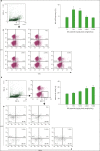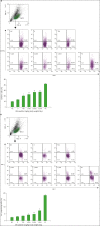Oral Administration of Silk Peptide Enhances the Maturation and Cytolytic Activity of Natural Killer Cells
- PMID: 30402332
- PMCID: PMC6215900
- DOI: 10.4110/in.2018.18.e37
Oral Administration of Silk Peptide Enhances the Maturation and Cytolytic Activity of Natural Killer Cells
Abstract
Silk peptide, the hydrolysate of silk protein derived from cocoons, has been employed as a biomedical material and is believed to be safe for human use. Silk peptide display various bioactivities, including anti-inflammatory, immune-regulatory, anti-tumor, anti-viral, and anti-bacterial. Although earlier investigations demonstrated that silk peptide stimulates macrophages and the production of pro-inflammatory cytokines, its effect on natural killer (NK) cell function has not yet been explored. In this study, we initially confirmed that silk peptide enhances NK cell activity in vitro and ex vivo. To assess the modulatory activity of silk peptide on NK cells, mice were fed various amounts of a silk peptide-supplemented diet for 2 months and the effects on immune stimulation, including NK cell activation, were evaluated. Oral administration of silk peptide significantly enhanced the proliferation of mitogen- or IL-2-stimulated splenocytes. In addition, oral silk peptide treatment enhanced the frequency and degree of maturation of NK cells in splenocytes. The same treatment also significantly enhanced the target cell cytolytic activity of NK cells, which was determined by cell surface CD107a expression and intracellular interferon-γ expression. Finally, oral administration of silk peptide stimulated T helper 1-type cytokine expression from splenic lymphocytes. Collectively, our results suggest that silk peptide potentiates NK cell activity in vivo and could be used as a compound for immune-modulating anti-tumor treatment.
Keywords: Cytokine; Cytolytic activity; In vivo; Natural killer cells; Silk peptide.
Conflict of interest statement
Conflict of Interest: The authors declare no potential conflict of interest.
Figures





Similar articles
-
Silk peptide treatment potentiates natural killer cell activity in vitro and induces natural killer cell maturation and activation in mouse splenocytes.Pharm Biol. 2019 Dec;57(1):369-379. doi: 10.1080/13880209.2019.1617749. Pharm Biol. 2019. PMID: 31156004 Free PMC article.
-
Ethanol suppression of the hypothalamic proopiomelanocortin level and the splenic NK cell cytolytic activity is associated with a reduction in the expression of proinflammatory cytokines but not anti-inflammatory cytokines in neuroendocrine and immune cells.Alcohol Clin Exp Res. 2006 Nov;30(11):1925-32. doi: 10.1111/j.1530-0277.2006.00237.x. Alcohol Clin Exp Res. 2006. PMID: 17067358
-
Heat shock protein 70 (Hsp70) stimulates proliferation and cytolytic activity of natural killer cells.Exp Hematol. 1999 Nov;27(11):1627-36. doi: 10.1016/s0301-472x(99)00104-6. Exp Hematol. 1999. PMID: 10560910
-
Interferon-gamma: biologic functions and HCV therapy (type I/II) (1 of 2 parts).Clin Ter. 2006 Jul-Aug;157(4):377-86. Clin Ter. 2006. Retraction in: Clin Ter. 2008 May-Jun;159(3):207. PMID: 17051976 Retracted. Review.
-
Shaping of Natural Killer Cell Antitumor Activity by Ex Vivo Cultivation.Front Immunol. 2017 Apr 26;8:458. doi: 10.3389/fimmu.2017.00458. eCollection 2017. Front Immunol. 2017. PMID: 28491060 Free PMC article. Review.
Cited by
-
Enzymatic bioconversion of ginseng powder increases the content of minor ginsenosides and potentiates immunostimulatory activity.J Ginseng Res. 2022 Mar;46(2):304-314. doi: 10.1016/j.jgr.2021.12.005. Epub 2021 Dec 17. J Ginseng Res. 2022. PMID: 35509827 Free PMC article.
-
Supplementation with a Natural Source of Amino Acids, Sil-Q1 (Silk Peptide), Enhances Natural Killer Cell Activity: A Redesigned Clinical Trial with a Reduced Supplementation Dose and Minimized Seasonal Effects in a Larger Population.Nutrients. 2021 Aug 24;13(9):2930. doi: 10.3390/nu13092930. Nutrients. 2021. PMID: 34578808 Free PMC article. Clinical Trial.
-
Silk peptide treatment potentiates natural killer cell activity in vitro and induces natural killer cell maturation and activation in mouse splenocytes.Pharm Biol. 2019 Dec;57(1):369-379. doi: 10.1080/13880209.2019.1617749. Pharm Biol. 2019. PMID: 31156004 Free PMC article.
-
Silk Peptide Ameliorates Sarcopenia through the Regulation of Akt/mTOR/FoxO3a Signaling Pathways and the Inhibition of Low-Grade Chronic Inflammation in Aged Mice.Cells. 2023 Sep 12;12(18):2257. doi: 10.3390/cells12182257. Cells. 2023. PMID: 37759480 Free PMC article.
References
-
- Mandal A, Viswanathan C. Natural killer cells: in health and disease. Hematol Oncol Stem Cell Ther. 2015;8:47–55. - PubMed
-
- Moretta L, Ciccone E, Moretta A, Höglund P, Ohlén C, Kärre K. Allorecognition by NK cells: nonself or no self? Immunol Today. 1992;13:300–306. - PubMed
-
- Vivier E, Tomasello E, Baratin M, Walzer T, Ugolini S. Functions of natural killer cells. Nat Immunol. 2008;9:503–510. - PubMed
-
- Smyth MJ, Crowe NY, Hayakawa Y, Takeda K, Yagita H, Godfrey DI. NKT cells - conductors of tumor immunity? Curr Opin Immunol. 2002;14:165–171. - PubMed
LinkOut - more resources
Full Text Sources

